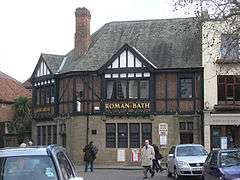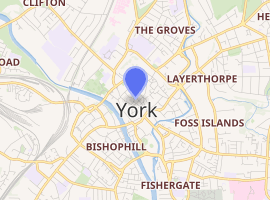Roman Bath, York
The Roman Bath is a public house in St Sampson's Square, in the city of York, in England. It is built above an ancient Roman bath house. The remains were uncovered during building work when the present pub was erected in 1929-31 replacing an inn. The exterior has Tudor Revival features including applied half-timbering. The pub is however more notable for the Roman remains which can be viewed inside.
| The Roman Bath | |
|---|---|
 "The Roman Bath" from St Sampson's Square | |

| |
| General information | |
| Type | Public House and Roman ruins |
| Architectural style | Tudor Revival (pub) |
| Designations | Grade II* |
The bath house apparently served the military personnel of Eboracum (Roman York). Not only was the facility was in Eboracum´s fortress (built in the 1st century AD to house a legion of about 5,000 men),[1] but also tiles have been discovered at the bath house site which are marked with the identity of specific legions. The Ninth may have constructed the facility. The last attested activity of the Ninth in Britain is in AD 108.
Baths dating from the 2nd and 3rd centuries AD have been excavated in another part of York: these are believed to have served the civilian population.[2]
Access and conservation
The pub is a Grade II* listed building. It was listed in 1954, relatively early for a pub from the interwar period.[3] This suggests that the existence of Roman ruins was the main reason for listing.
The Roman remains may be visited. A fee is payable.[4]
.jpg)
The caldarium and some other features of the baths are visible.[1] Some of the other facilities would have been outside the corner site occupied by the pub: much of the baths have yet to be excavated. The site as a whole is protected through its location within the walled city of York, designated as an 'Area of Archaeological Importance' (AAI) under Part 2 of the 1979 Ancient Monuments and Archaeological Areas Act.
See also
There are other examples in the UK of Roman baths serving forts, for example the infrastructure at Caerleon, also a legionary fortress, where there was a frigidarium, tepidarium and caldarium, as well as an open-air swimming pool.[5]
The Six Bells in St Albans, is also built above a bath house, but the Roman remains are not on display.
References
- "Inside the Roman Fortress". History of York. Retrieved 2018-01-26.
- "Roman baths are uncovered in York". 2011.
- In 2015 Historic England listed a number of interwar pubs at which time it was noted that relatively few such buildings survived unaltered. See Belger, Tom (2015). "Look inside the Wheatsheaf". Liverpool Echo. Retrieved 11 January 2019.
- "Roman Bath Public House". Retrieved 2019-01-12.
- "Caerleon Roman Fortress and Baths". cadw.gov.wales. Retrieved 2018-01-27.
External links
| Wikimedia Commons has media related to Roman Bath York. |